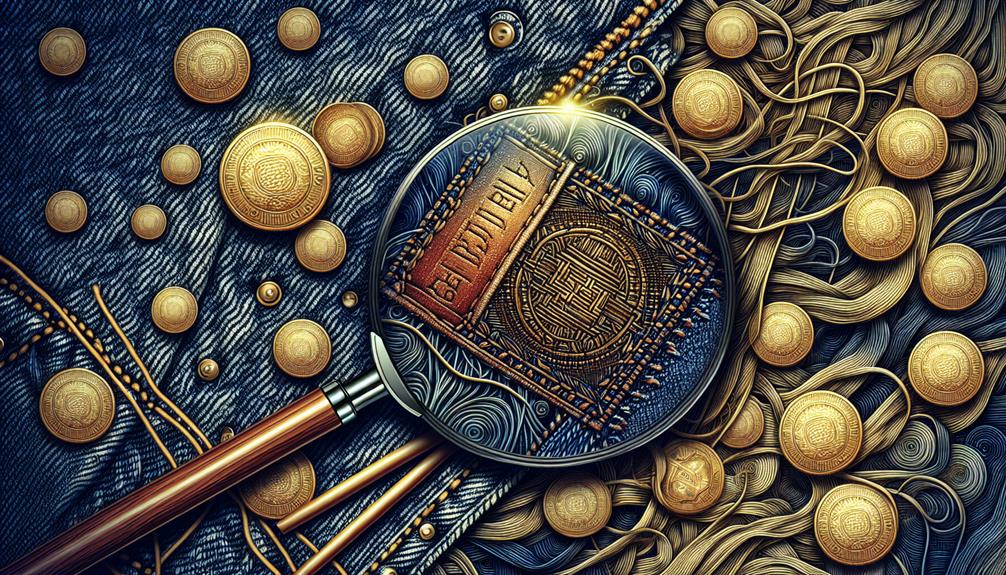I've always been curious about why we're shelling out so much for denim. It's not just a piece of clothing; it's a statement, but does the cost truly reflect its value? From the premium cotton fibers to the unique dyeing processes that give denim its distinctive look, there's a lot under the surface. Add in the craftsmanship and the push for sustainable and ethical production, and the price tag starts to make sense. But is there more to the story? Join me as we unravel the layers behind the hefty price tag of denim.
Table of Contents
Key Takeaways
- Premium cotton fibers and specialized dyeing processes increase production costs.
- Intricate weaving on vintage looms requires skilled labor, driving up prices.
- Unique design features and craftsmanship entail high-quality control measures.
- Ethical production and sustainable sourcing practices contribute to higher expenses.
- Brand heritage and market demand for quality denim justify premium pricing.
The Raw Materials
The heart of why denim's pricey lies in its raw materials, notably the premium cotton fibers and the traditional indigo dyeing process. When we're talking about high-quality denim, we're diving into a world where the fabric isn't just fabric—it's a canvas of craftsmanship. Think long-staple Pima or Egyptian cotton; these aren't your everyday cotton fibers. They're softer, more durable, and yeah, they cost a pretty penny. But you're not just paying for the material itself. The craftsmanship that goes into weaving these fibers, especially when we're talking selvedge denim, is another level.
Selvedge denim, that's the good stuff, made on old-school shuttle looms that take their sweet time to create a denser, more robust fabric. And because these looms are slower, the labor costs go up. Then there's raw denim, this untouched, unwashed beauty that showcases the cotton in its most natural form. It demands higher quality materials right from the get-go, pushing the price tag even higher. So, when you're shelling out for a pair of premium jeans, remember, you're paying for quality materials, time-honored craftsmanship, and yeah, those labor costs that bring it all to life.
Specialized Dyeing Processes
Moving beyond the premium cotton and craftsmanship, let's focus on another key factor ramping up denim's price: specialized dyeing processes. These aren't your everyday dye jobs. We're talking about techniques that require a level of skill and time that directly feed into the cost of your favorite jeans.
Let's break it down:
| Process | Requires | Impact on Price |
|---|---|---|
| Natural Indigo | Fermentation, skilled artisans | $$$ |
| Synthetic Dyeing | Chemical treatments | $$ |
| Unique Techniques | Exclusive colors, finishes | $$$$ |
Natural indigo dyeing isn't just tossing some dye in a vat; it's an art. It involves fermentation and precise temperature control, which means more time and more skilled hands. On the other hand, synthetic dyeing processes bring their own set of costs with chemical treatments and technologies aimed at achieving the perfect hue. And let's not forget, brands are always pushing the envelope with unique dyeing techniques to stand out, which adds to the tab.
Why does this matter? Well, these processes play a huge role in the quality denim you're after, not just in terms of look but also in how well your jeans hold onto their color. High-quality dyeing means better color retention, which equals jeans that stay looking great longer.
Intricate Weaving Techniques
So, let's talk about why that pair of jeans isn't just a simple piece of clothing.
It's all about the specialized looms and the incredible skill and craftsmanship that go into making them.
This intricate weaving technique isn't just for show; it's what makes your denim last longer and feel better.
Specialized Loom Requirements
Because denim's quality hinges on its weave, specialized looms that demand intricate techniques play a crucial role in its production. These aren't your run-of-the-mill machines; we're talking about vintage looms, some of which are over 70 years old, tasked with crafting high-quality denim.
The catch? Maintaining these ancient tech marvels is a complex affair, requiring operators with a unique set of skills. Moreover, their production speed doesn't hold a candle to modern machinery, significantly lowering output. This slow, meticulous process is a key driver behind denim's hefty price tag.
The scarcity of these specialized looms, combined with the craftsmanship they necessitate, underscores the premium placed on denim. It's a clear case of 'you get what you pay for.'
Craftsmanship and Skills
While we've touched on the importance of specialized looms, it's the craftsmanship and skills behind intricate weaving techniques that further justify denim's high price.
- Selvedge denim production stands out for its quality and durability, which stems from old-school weaving practices.
- The use of vintage weaving looms, some dating back over 70 years, adds a unique value that's hard to replicate.
- Skilled operators are crucial, as they maintain and operate these complex machines, driving up labor costs.
- These specialized looms work at slower speeds, meaning less output but higher quality, impacting the final price.
- Lastly, much of this top-tier selvedge denim is made in Japan, a country renowned for its dedication to craftsmanship, further influencing the premium pricing.
Understanding these factors, I can appreciate why denim, especially of the selvedge variety, commands such a price.
Sustainable Sourcing
Often, when we talk about the cost of denim, we don't immediately think about the impact of its sourcing, but sustainable practices are crucial for the environment and our wardrobes. Sustainable sourcing isn't just a buzzword; it's about making sure the fabric used in our jeans doesn't harm the planet. Organic cotton cultivation plays a huge role here. It slashes chemical use, supporting soil health and biodiversity. This isn't just good farming; it's about preserving our world for future generations.
Then, there's the magic of recycled denim fibers. Reusing materials means less waste, reducing the environmental impact and adding a layer of responsibility to our fashion choices. It's not just about creating sustainable denim products; it's a statement about how we value our resources.
But it's not only about the environment. Sustainable sourcing also touches on fair trade practices, ensuring that the people who make our jeans are treated fairly. Brands committed to this cause are all about transparency, allowing us to trace our jeans back to their roots. So, when we consider denim costs, remembering the importance of sustainable sourcing gives us a fuller picture of why every pair is worth its price.
Ethical Production Standards
When we look at why denim can be pricey, we can't ignore the role of ethical production standards. Fair labor practices and using eco-friendly materials ramp up the costs, but for a good reason.
They ensure we're wearing jeans that didn't harm the planet or exploit workers, making that extra cost worth it.
Fair Labor Practices
Denim's high price tag can also reflect the fair labor practices adopted by brands, ensuring that workers are paid well and work in safe conditions. When we dive into why ethical production standards ramp up the cost, it's all about the commitment to:
- Providing living wages
- Offering benefits to employees
- Upholding high safety standards
- Committing to sustainable practices
- Being socially responsible
Investing in these aspects means brands are prioritizing their workers' well-being over cutting costs.
As a consumer, when I choose denim from companies that champion these values, I'm not just buying a pair of jeans. I'm supporting a system that values people as much as profits, contributing to a more ethical and sustainable fashion industry.
Eco-Friendly Materials
Switching gears to eco-friendly materials, it's clear they're a game-changer in crafting denim with a lighter environmental footprint. Utilizing sustainable materials like organic cotton, recycled fibers, and plant-based dyes, eco-friendly denim takes a stand against conventional practices by drastically reducing water, energy, and chemical usage.
It's not just about the materials, though. Ethical production standards shine a spotlight on fair labor practices, ensuring worker safety and social responsibility are at the forefront of the manufacturing process. Certifications like GOTS and Oeko-Tex play a crucial role, serving as a badge of honor for brands that meet these rigorous standards.
Design Innovation
Design innovation is key in making denim stand out, involving everything from unique washes to high-tech finishes. When I dive into why jeans come with a hefty price tag, the spotlight often lands on design innovation. Premium denim doesn't just happen; it's a deliberate concoction of creativity and technology. Here's how it breaks down:
- Unique washes, distressing techniques, and embellishments add that exclusive vibe, pushing up the price.
- Premium brands go the extra mile with hand sanding and whiskering to hit the trend nail right on the head.
- Cutting-edge tech like laser finishing and ozone washing create those intricate patterns and textures we all crave.
- Collaborations with artists and influencers birth limited edition pieces that scream individuality.
- Sustainable practices in design don't just aim for style but also prioritize reducing environmental footprints.
These elements of design innovation aren't just about making jeans look good; they're about crafting a story, a personality behind each pair. This narrative, coupled with the demand for sustainable, unique pieces, justifies the premium tag on denim. Understanding the depth of innovation involved helps unravel the puzzle of why premium denim often comes with an expensive price.
Craftsmanship and Labor
A significant factor in denim's high cost is the skilled craftsmanship and labor that go into making each pair. Crafting a pair of high-end jeans isn't just about stitching fabric together; it's an art. The use of high-quality materials, like premium cotton for selvedge denim, requires specialized techniques that only experienced artisans can handle. These experts employ intricate processes, from selvedge denim weaving to hand-stitching, adding unique finishes that machine production simply can't replicate.
The labor involved isn't your run-of-the-mill task. It's meticulous and time-consuming, involving steps like distressing and hand sanding, which add character to each piece. These labor-intensive processes are crucial for achieving the distinct look and feel that denim aficionados adore. Plus, the attention to detail, such as hand-sewn embellishments, further elevates the value of the final product.
This level of craftsmanship and labor doesn't come cheap. The expertise, time, and effort invested by these skilled artisans directly contribute to the higher prices of denim products. It's not just about the materials; it's the human touch, the artistry, and the dedication to quality that you're paying for.
Quality Control Measures
Beyond the artistry and effort artisans pour into each pair, it's the rigorous quality control measures that really set premium denim apart. When I delve into why my favorite selvedge denim comes with a hefty price tag, I'm reminded of the meticulous attention to detail that ensures every inch of fabric meets the highest standards. Here's what makes the cut for premium denim:
- Inspections at every production stage: This keeps the fabric's integrity in check from weaving to final product.
- Weaving irregularities checks: Even the slightest flaw is a no-go, ensuring the durability that premium denim is known for.
- Color consistency evaluations: You won't find unexpected dye variations here, which speaks volumes about the quality control rigor.
- Fabric strength tests: It's all about longevity, making sure that the denim holds up over time without compromising its feel.
- Skilled technicians' approval: Only the best eyes and hands assess and approve the final product, guaranteeing fabric quality and performance.
This level of quality control is what sets selvedge and premium denim apart from the rest. It's not just about the material; it's the assurance that your denim can stand the test of time, maintaining both its durability and fabric integrity.
Brand Heritage
Moving on to brand heritage, it's clear this aspect isn't just fluff—it's central to why we're often willing to pay more for our jeans.
Historical significance boosts a brand's credibility, convincing us that we're not just buying a pair of pants, but a piece of history.
This perception of quality, rooted in a brand's storied past, makes shelling out extra cash seem worth it.
Historical Significance
Delving into the historical significance of Levi Strauss & Co., it's clear that their legacy, dating back to the 19th century, plays a crucial role in the brand's premium pricing today. Their journey isn't just about creating denim jeans; it's a story of innovation, quality, and heritage that resonates with consumers.
- Levi Strauss pioneered the denim industry, setting the foundation for what jeans mean today.
- The 501 jeans have become synonymous with durability and timeless style.
- Levi's has adeptly evolved with fashion trends while honoring their roots.
- Their craftsmanship isn't merely about making jeans but crafting icons.
- Understanding the heritage behind Levi's adds a layer of appreciation for their premium pricing.
It's this rich history that justifies why their denim commands a higher price.
Quality Perception
It's undeniable that a brand's heritage significantly boosts the quality we perceive in their denim. Take Levi's, for instance. Their long history of crafting durable, iconic jeans isn't just a story; it's a testament to their commitment to quality.
This brand heritage speaks volumes. When I pick up a pair of Levi's, I'm not just buying jeans; I'm investing in years of craftsmanship and a legacy of premium denim. This background justifies their price tag in my mind.
The quality perception tied to brand heritage isn't superficial. It's rooted in a proven track record of superior craftsmanship and long-lasting products. It's why, when contemplating the cost of premium denim, the legacy of a brand like Levi's makes it seem worth every penny.
Market Demand
Driven by a shift towards sustainable and high-quality fashion, market demand for premium denim has seen a significant increase. It's not just about wearing jeans anymore; it's about making a statement with your choices and supporting values that matter. The rise isn't random; it's a direct reflection of evolving consumer preferences and a collective push towards sustainability.
Here's why the market is buzzing over premium denim:
- Sustainable fashion isn't a trend, it's a movement. More folks are opting for denim brands that prioritize the planet.
- High-quality production means jeans aren't just durable; they're a form of investment in one's wardrobe.
- Denim brands are stepping up, focusing on craftsmanship and ethical production, aligning with consumer values.
- Limited edition releases add a layer of exclusivity, making each piece feel special.
- The fight against fast fashion has led to a willingness to pay more for denim that promises longevity and minimal environmental impact.
It's clear premium denim isn't just fabric and thread; it's a lifestyle choice. As a denim aficionado, I'm all in for this shift. It's about time our jeans reflected our values as much as our style.
Frequently Asked Questions
Why Is Real Denim so Expensive?
I've noticed real denim's pricey because it's made from high-quality cotton, involves meticulous craftsmanship, and uses advanced construction techniques. This all adds up, ensuring the denim is soft, durable, and worth the investment.
What Is Special About Denim?
Denim's special because it's durable, gets better with age, and uniquely fades to fit your lifestyle. It's not just fabric; it's a canvas that tells your story through its wear and tear.
Why Is Denim in Such High Demand?
I've noticed denim's high demand stems from its versatility, durability, and timeless appeal. It's a wardrobe staple that adapts to trends, bolstered by celebrity endorsements and a growing focus on sustainability in fashion.
Is It Worth Paying for Expensive Jeans?
I think it's worth paying for expensive jeans. They last longer, feel softer, and offer a better fit. Over time, their cost per wear makes them a smarter buy than cheaper options.
- What to Do With Lightweight Bouclé Yarn: Project Ideas - July 3, 2025
- What Style Is Bouclé? From Mid-Century Modern to Cozy Contemporary - July 3, 2025
- What Ply Is Bernat Soft Bouclé Yarn? - July 3, 2025






